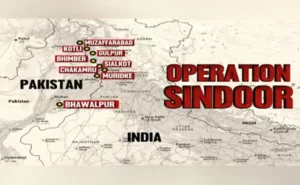
An in-depth analysis of India’s strategic response to Operation Sindoor

Targeting nine locations throughout Pakistan and Pakistan-administered Kashmir, India began a massive military operation known as Operation Sindoor on the evening of May 6, 2025. The horrific Pahalgam attack on April 22, which claimed the lives of 26 civilians, mostly Hindu tourists, prompted this action. Tensions between the two nuclear-armed neighbours increased when India blamed the attack on militants supported by Pakistan.
What Was the Target?

The Indian military launched a 23-minute attack using Rafale aircraft fitted with AASM Hammer bombs and SCALP missiles. The operation targeted what India called “terrorist infrastructure” associated with organisations including Hizbul Mujahideen, Jaish-e-Mohammed, and Lashkar-e-Taiba. Bahawalpur, Muridke, Sialkot, Kotli, Bhimber, and Muzaffarabad were among the important sites that were struck. Notably, in an effort to prevent escalation and civilian losses, the Indian Ministry of Defence stressed that no Pakistani military installations were hit.
Pakistan’s Response
Pakistan condemned the strikes as an “act of war,” with Prime Minister Shehbaz Sharif vowing a robust retaliation. In the immediate aftermath, Pakistan reported the deaths of 26 civilians and injuries to 46 others, including women and children. The strikes also reportedly damaged civilian infrastructure, including mosques. Pakistan claimed to have shot down five Indian aircraft, although India has not confirmed these reports. In retaliation, Pakistan shelled Indian-controlled Kashmir, resulting in the deaths of three civilians .
Global Responses
Resilience
 The growing tensions caused great alarm among the international community. António Guterres, the UN secretary-general, urged India and Pakistan to exercise the utmost moderation. President Donald Trump of the United States called India’s strikes “a shame,” and he urged both countries to defuse the situation.
The growing tensions caused great alarm among the international community. António Guterres, the UN secretary-general, urged India and Pakistan to exercise the utmost moderation. President Donald Trump of the United States called India’s strikes “a shame,” and he urged both countries to defuse the situation.
Strategic Consequences
Operation Sindoor highlights the precarious security situation in the Kashmir region and is a significant development in the continuing India-Pakistan stalemate. Although India intended to target terrorist infrastructure, the story has become more complex due to Pakistan’s stated civilian losses and collateral damage. In an area already riven by historical tensions, the operation highlights the difficulties of carrying out pinpoint strikes in crowded populations and the possibility of quick escalation.
The Attack on Pahalgam
Five armed militants opened fire on a group of tourists during the Pahalgam incident in Jammu and Kashmir’s Baisaran Valley. The attackers, who were equipped with AK-47s and M4 carbines, insisted that men repeat Islamic prayers before they were executed. They intentionally targeted non-Muslim visitors, avoiding women and children. Twenty-eight people were killed in the attack, including one local and 25 tourists. An affiliate of Lashkar-e-Taiba, the Resistance Front (TRF), first claimed responsibility for the attack but later withdrew the claim, blaming Indian intelligence of planning it.
Operation Sindoor: The Reaction of India
 India responded by launching precision attacks against what it called “terrorist infrastructure” associated with organisations including Lashkar-e-Taiba, Jaish-e-Mohammed, and Hizbul Mujahideen using Rafale jets fitted with SCALP missiles and AASM Hammer bombs. In an effort to prevent escalation and civilian losses, the Indian Ministry of Defence stressed that no military installations in Pakistan were targeted.
India responded by launching precision attacks against what it called “terrorist infrastructure” associated with organisations including Lashkar-e-Taiba, Jaish-e-Mohammed, and Hizbul Mujahideen using Rafale jets fitted with SCALP missiles and AASM Hammer bombs. In an effort to prevent escalation and civilian losses, the Indian Ministry of Defence stressed that no military installations in Pakistan were targeted.
The operation was justified as a “focused, measured, and non-escalatory” response to the Pahalgam attack by the Indian government. According to a Ministry of Defence press release, the operation, which lasted roughly 23 minutes, targeted nine targets. The government said that rather than targeting military or civilian targets, the strikes were directed at terrorist infrastructure.
The Response of Pakistan
As a “act of war,” the strikes were denounced by Pakistan, and Prime Minister Shehbaz Sharif promised a fierce response. According to Pakistan, 46 civilians, including women and children, were injured and 26 civilians died. Mosques and other civilian infrastructure were reportedly harmed by the strikes. India has not substantiated Pakistan’s claims that it shot down five Indian planes. Three people were killed when Pakistan shelled Indian-controlled Kashmir in retaliation.





